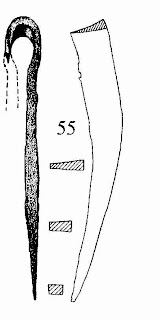Several medieval woodworking trades make use of the drawknife, like the bow maker, the wheelwright, the carpenter, the clog maker, but also the turner and joiner know how to use this versatile tool. A drawknife is a sharpened blade with two handles at its ends. It is pulled towards the user over the wood, hence its name. The blade of the drawknife can be slightly curved. Specialised forms of drawknives exist that are used to hollow out forms. These types are called inshaves. An inshave with a completely rounded blade and only handle is called a scorpe.
The length of the blade is dependent on the use or woodworking trade and could be between 8 and 40 cm. For joiners the length is usually between 20 and 30 cm. The blade usually has an angle on one side between 25 and 30 degrees, but sometimes a small bevel (5 degrees) is found on the other side.
A small Anglo-Saxon inshave from York. The two tangs were originally 124 mm long.
The width of the blade is 30 mm, total width 103 mm, depth 71 mm, length 135 mm.
Image from Wood and woodworking in Anglo-Scandinavian and medieval York.
The length of the blade is dependent on the use or woodworking trade and could be between 8 and 40 cm. For joiners the length is usually between 20 and 30 cm. The blade usually has an angle on one side between 25 and 30 degrees, but sometimes a small bevel (5 degrees) is found on the other side.
As a drawknife needs to be used with both hands, the piece of wood has to be fastened so something else. Usually this is a shaving horse or a workbench. We use the drawknife for cleaning and roughly rounding pieces of wood for the pole lathe, as well as for rounding edges of furniture (like the sella curulis). However the drawknife can also be used to smoothen rough beams and planks instead of a plane. The monk Theophilus mentions the drawknife for this use in his book "On divers arts" (1122 AD), Book 1, Chapter 17 (panels for altars and doors and cheese glue):
When panels have been glued together with this [cheese] glue, they stick together so well when they are dry that they can not be separated by dampness or heat. Afterwards they should be smoothed with a planing tool [ i.e. a drawknife] which is curved and sharp on the inside and has two handles so that it can be drawn with both hands. Panels, doors and shields are shaved with this until they become completely smooth.
Drawknives, inshaves and scorps found in Novgorod. Right photo: several inshaves. Left drawing: (a) 11th century drawknfe, (b and c) 13th century drawknives, (d) inshave 14th century, (e) inshave 11th century, (f)inshave 14-15th century, (g) inshave 13th century, (h) image from a miniature in the book "Life of St. Sergius of Radonezh" from 16th century showing the use of an inshave, (j) scorpe 14th century. Images from the book "Wood use in medieval Novgorod".
The drawknife is an old tool. Some have been found in the Mastermyr chest (1000 AD). Also in Novgorod, Russia drawknives have been found from the 10th century onwards with blade lengths between 30-40 cm. Inshaves appear from the 12th century onwards, some have the wooden cylindrical handles (22-24 mm diameter) still attached. W.L. Goodman mentions in his 'History of woodworking tools' that the drawknives were called skobel in medieval Russia and used for smoothing the surface of the timber after using the adze or axe, like the description of the drawknife by Theophilus..
Two inshaves from the Mastermyr chest, 1000 AD.
Drawknives are shown in several of the trades found in the Mendelschen and Landauer Hausbucher, as well as in many other medieval illustrations.
Left, Kuntz Franck, clogmaker († 1489.08.23.) with four drawknives hanging at the wall.
Right, Vlrich vo(n) der Hul, wheelwright († 1451.09.22.) with one drawknife lying on the ground.
Both images from the Mendelschen hausbuch.
Detail from the miniature 'Life of the anachorites' in De origine fundatoribus et regalis monachorum et monacharum, second half of the 14th century. Vienna, national Library, Cod. 341, fol. 32. The image shows a monk using a drawknive on a piece of wood.
Detail showing two drawknives from an illustration in "Van der Dyngen Erfyndung" by Polydor Vergil, 1537 (f. VCr.)
Vom Bergkwerk of Georgius Agricola (1557) shows a combination of drawknife with shaving horse.
A second drawknife lies on the ground.
We have several drawknives in our medieval toolchest (not all are shown). Our drawknifes are antique, dating from the start of the last century. The small drawknife also has a second, slight angle on the other side of around 5 degrees. The length of the blade varies between 20 and 40 cm.














Hi, i have read through a part of your fantastic blogg and i am much impressed!
ReplyDeleteI am apart of a reenactment association called fraternis melitia Carnis, located in sweden. www.carnis.org
I wounder if you would like to help me with some tips and pointers for medieval furniture?
if so you can find me at kare.moller (at) gmail.com
Thanks!
//Kåre
The most important tip is a modern one: You should plan the size of your furniture such that it would fit into your car. This became a problem for us.
DeleteI designed the medieval toolchest in 2005 to fit in nicely our car, an opel astra stationwagon. 105 cm width was ok for that car. A year ago we had to buy a new one, but meanwhile cars became more streamlined, etc. and it was very difficult to find a new car that had a width of 105 cm. We now have a newer opel astra model but we need to turn the chest on the flattened back seats to get it back on the loading platform.